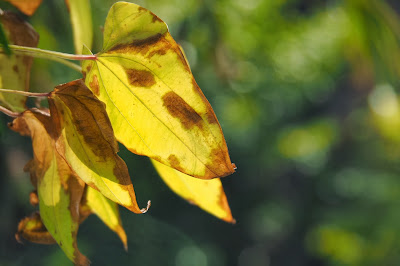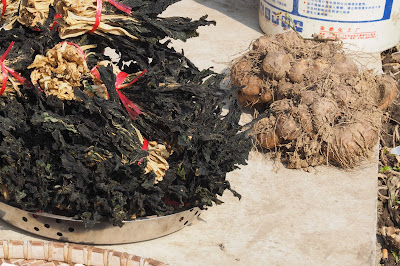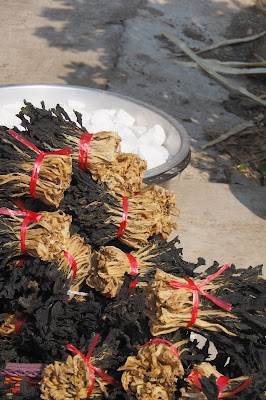The trip meant meeting at the Futian Port Station across the border from Lok Ma Chau MTR station 7 a.m. in the morning. I arrived early and waited for the late comers but didn't have to wait long. We had a tour leader and a local guide. Our tour leader was a lovely young lady trying her nervous best to look self-confident and competent. Our local tour guide was her complete opposite: a seasoned loud-mouth, no nonsense tom-boy whose jokes about some of the things which could happen would make us gasp for breath from belly aches from laughing too hard. One of her "would-you-believe it?" tales concerned her anxieties during one of her many tours: after several hours of urgent telephone calls to and from the hotel management and her, one old couple who vigorously denied having left anything important inside a combination-lock operated hotel room safe deposit box despite a message requesting for combination lock number code from the hotel manager for their locked safe deposit box, something nobody expected was discovered after the they called in an expert locksmith: a "pineapple bun" which the old couple bought from a restaurant where they lunched earlier in the day because they mistook the safe deposit box for a micro-wave oven and then decided to abandon their pre-bedtime snack because they couldn't remember the combination number a minute after they put it in!
This is the protective causeway of an exclusive yacht club in Nam Sha which we passed in the early morning. We're told that one would now have to pay more than RMB1 million odd just to join.
One of the numerous tributaries of the Pearl River Delta
It's all fishing ponds on either side of the superhighway
A container port we passed
Everywhere we passed, there were construcions
Our first stop. Floating Moon Village (浮月村)

The memorial plaque designating the 15 buildings "protected buildings".

A panoramic view of the 15 buildings ( Photo from the internet). Its 15 "Western-style" buildings were declared to be part of "world heritage buildings" by the UNESCO in July 2002. They're located at Floating Moon Village of the Dau Shan Township (斗山镇墩头村委会浮月村,). The buildings are called respectively 中山阁、贤安庐、安雅庐、兰芳居、觉庐、蓁华居、恒安居、仕庐、英庐、源庐、炯庐、鋈庐、晃庐、惠华居和陈国旗楼, all named after the original brothers who built or financed their construction. The oldest one 惠华居 was built in 1917 and the youngest one 觉庐 in 1936. The brothers had emigrated to America and/or Europe in the early 20th century. There are Toi Shan emigrants now in 92 different cities all over the world and its overseas population now number 1.3 million, much more than even the 930,000 in Toi Shan Municipal area and 730,000 more than Hoi Ping. There are now more than 2,500 fort-houses (碉樓) here but they are not so well known as those in Hoi Ping but with "Let the bullets fire" (讓子彈飛》starring Chow Yun Fat (周潤發), they are now getting more attention.
The rice has been harvested, leaving sheaves of dry paddy stalks in the field
There is a huge pond in front of the village where the villagers may find all they need for good quality protein. They got rice, they got vegetables, they sugarcanes, they got chickens and eggs, they got timber and firewood from nearby woods, they got fish, they got chicken: all they need for a good living. Hence the village is a target for plunders by bandits.
The village is relatively clean
They combine the traditional fort-houses for self-defence against local bandits and western-style buidings. This one has fort-towers at its two corners and a combination of roman Roman columns and Greek pillars: the lower floors are used only as work rooms and for storage whilst only the upper floors are for living purposes.
This one had a roundish fort-like projection at its corners with tiny windows: its windows are typically small and placed high up the relevant floors. On the roof, there are small openings from which guns can fire at the bandits.
This one has too has small window fitted with iron bars.
This is one of the tallest. Note that its windows are all fitted with iron bars and in addition, has metal covers, not just shutters.
Even on the top floor, the doors have metal grilles and metal protective door-shields.
A top floor balcony in the building in front and a Roman domed-pavilion in the building behind
All the members of this village are surnamed Chan. This is the back of their ancestral hall
The front of the Chan's ancestral hall
A close up of the entrance . There are Chinese paintings on each side and at the centre

The ancestral altar It reads: flowers from a thousand branches bloom in the same profusion; water flowing into a ten thousand vessels from the same ancient source.
The young having all left for the excitement of nearby cities or gone overseas, sitting around and puffing the day away may not be a bad way of whiling away their leisure after they'd one cooking and washing for the older village folks.
A typical small strong window. This one has a wooden window-shield.
This is the typical window on the ground floor of the non-fort-house buildings
Thick wooden window shield with bolts
Another window with iron bars
Traditional urns and glazed pots serving as "flower" pots
Make-shift DIY repairs
In a village, space is never wasted: fruit skin being dried on the window sill
A Western style door arch

The grounds between buildings are not wasted: A triangular scaffold for growing beans or other climbing plants
leaves in the sun
A bamboo chicken cage sitting at the back of a motor-bike: a combination of the old the new.
Black sugar cane ready for transport to town for sale
Some local root plant for sale
Dried vegetable and some other roots
.
.
More bundles of dried veggies for soup making
A fat little chicken pecking away
This is a type of creeper with very long air roots which the villagers would tie into ribbons!

A close up of some of such air roots.
Chickens are allowed to run free. One of the favourite local recipes is chicken cooked with a whole panful of sea-salt in a huge wok!






































沒有留言:
張貼留言